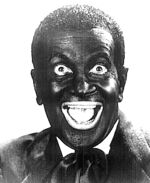Shoe polish
“Well if you had told me you were just wearing shoe polish then I obviously wouldn't have stabbed you!”
“Thats how we got black people !!!”

Shoe polish (or boot polish to limeys), is a consumer product used for the application of blackface in the hilarious, uncontroversial and universally beloved art form of the minstrel show. It is also occasionally known to be used to polish shoes, although the word “polish” actually derives from the product’s West Slavic origin.
Various substances have been used as shoe polish over the years, including turpentine, gum arabic, gum cyrillic, gum latin, boiling hot tar, chimney soot, charcoal bricks, and black tar heroin. However, in modern times shoe polish comes from a naturally occurring black wax that is mined by Kiwi slave labor.
Usage[edit]
Minstrelsy[edit]
Shoe polish is applied to the face using a tamponrag, cloth, or Mach 3 Triple Bladed Katana, though the latter hurts like a bitch. It should be applied evenly over all areas of the face except for the lips and the immediate area around them, which should be left unpainted or, even better, made scarlet red with lipstick. It may also be applied to the hands, yet that is usually unnecessary as the wearer should put on white gloves. *jazz hands*
Once application of shoe polish is complete, the individual will immediately be compelled with a desire to start singing jazz music and tap dance. When a minstrel show is completed, shoe polish may be easily removed with sandpaper.
To make the effect of the shoe polish more accurate and glossy, the skin should be made as dark and glossy as possible. This is often achieved through “spit shining” through the addition of spit to the shoe polish. Since it’s pretty hard to spit in your own face, have someone else spit on it before applying polish. Bukkake is an alternate method of achieving the same effect, though too much may cause the shoe polish to run.
To reflect accurate skin tones, shoe polish comes in a number of tones, including black, midnight black, onyx black, obsidian black, coal black, and glossy black.
On shoes[edit]
Shoe polish is also used, rarely, on shoes in the highly competitive sport of shoe shining. This game, also known as the sport of kings, is one of the most widely played in the world, crossing cultural boundaries (though it is especially popular amongst the people of Thailand, Luxembourg, Mexico and Airports). Shoe shining is rumored to become an Olympics event in 2008.
Shoe polish is applied on shoes the same way it is applied in minstrelsy. Except, like, on shoes instead of on faces. If you apply shoe polish to your face, it is highly unlikely that your shoes will become any shinier. Similarly, the addition of semen to make a glossier black is not only desired – but a rule of shoe shining.
History[edit]
Shoe polish was first invented in Poland during the 15th century, hence the term “Polish.” Shoe polish was just one of many great Polish inventions of the period, with others including submarines with screen doors, circular firing squads. It’s creation is usually credited to Jimski Crowski, who slipped while cleaning his chimney and walked out looking uproariously similar to the African people that were depicted on contemporary wood-block printings, except with gleaming shoes! Despite the fact that the American South did not exist yet, Crowski knew that there would immediately be a market for the product and began to sell it under the name “shoe polish” for some inexplicable reason.
The product went largely unnoticed for 400 years, until the 1800s when vicious iconic racism became all the rage. At the time the product was being sold as a cure-all remedy in a tin, because everything at the time was sold as a cure-all remedy in a tin. While some noticed the coincidental name and started using it on shoes, in Tennessee and other U.S. Red States its original purpose was once again realized and it became the hottest thing in the South since the cotton gin.
The early 1900s was they heyday of shoe polish usage, and demand became so high for the product that an alternative source was deemed necessary. A long search for a new shoe polish was underway, and in 1906 Australians hit an extensive vein of “the OTHER black gold,” which became known as shoe polish wax. It is this type of shoe polish that is known and loved today.
Mining[edit]
After the Australian discovery of a new source of shoe polish, they decided to bitch slap their little neighbor and make Kiwis mine it for them. Kiwis were enslaved and forced to the outback to mine shoe polish in remote parts of the outback. The conditions they worked in included oppressive heat, little food or water was given to sustain them, and many of their babies were eaten by dingos. But then again, it’s not called “slavery” because it’s a fun day in the park, now is it?
The intense labor of Kiwis results in the production of a 1 1/4oz (35g) can of “Kiwi shoe polish.” The purity of the mined wax determines the exact color of the polish, ranging from black to a slightly different shade of black.

